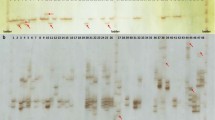Abstract
Eighteen microsatellite primer pairs previously developed at Oak Ridge National Laboratory for Populus tremuloides Michx. and Populus trichocarpa Torr. & Gray were screened for amplification in Euphrates poplar, Populus euphratica Oliv. Thirteen loci were found to express polymorphisms ranging from two to 17 alleles. The eight most variable loci were selected to set up and optimize two multiplex polymerase chain reaction (PCR) assays. Three populations containing altogether 436 trees were used to characterize the selected loci and ascertain their applicability for parentage analysis and genotyping studies. Through cross-checking of clonal identity against sex of the genotyped trees we estimated the maximum error rate for merging genotypes to be less than 0.045.
Similar content being viewed by others
References
Bruelheide H, Manegold M, Jandt U. 2004. The genetical structure of Populus euphratica and Alhagi sparsifolia stands in the Taklimakan desert. In: M. Runge and X. Zhang (eds), Ecophysiology and habitat requirements of perennial plant species in the Taklimakan desert. Contributions to a “Workshop on sustainable management of the shelterbelt vegetation of river oases in the Taklimakan desert”. Urumqi, pp. 153–160.
Dakin EE, Avise JC. 2004. Microsatellite null alleles in parentage analysis. Heredity, 93(5): 504–509.
Fay MF, Lledó MD, Kornblum MM, Crespo MB. 1999. From the waters of Babylon? Populus euphratica in Spain is clonal and probably introduced. Biodiversity and Conservation, 8(6): 769–778.
Gerber S, Chabrier P, Kremer A. 2003. FaMoz: a software for parentage analysis using dominant, codominant and uniparentally inherited markers. Molecular Ecology Notes, 3(4): 479–481.
Halkett F, Simon J, Balloux F. 2005. Tackling the population genetics of clonal and partially clonal organisms. Trends in Ecology and Evolution, 20(4): 194–201.
Henegariu O, Heerema NA, Dlouhy SR, Vance GH, Vogt PH. 1997. Multiplex PCR: critical parameters and step-by-step protocol. BioTechniques, 23(3): 504–511.
Hoffman JI, Amos W. 2005. Microsatellite genotyping errors: detection approaches, common sources and consequences for paternal exclusion. Molecular Ecology, 14(2): 599–612.
Lepais O, Léger V, Gerber S. 2006. Short Note: high throughput microsatellite genotyping in oak species. Silvae Genetica, 55(4/5): 238–240.
Rousset F. 2008. GENEPOP’007: a complete re-implementation of the GENEPOP software for Windows and Linux. Molecular Ecology Resources, 8(1): 103–106.
Saito Y, Shiraishi S, Tanimoto T, Yin L, Watanabe S, Ide Y. 2002. Genetic diversity of Populus euphratica populations in northwestern China determined by RAPD DNA analysis. New Forests, 23(2): 97–103.
Selkoe KA, Toonen RJ. 2006. Microsatellites for ecologists: a practical guide to using and evaluating microsatellite markers. Ecology Letters, 9(5): 615–629.
Stoeckel S, Grange J, Fernández-Manjarres JF, Bilger I, Frascaria-Lacoste N, Mariette S. 2006. Heterozygote excess in a self-incompatible and partially clonal tree species — Prunus avium L. Molecular Ecology, 15(8): 2109–2118.
Suzuki J, Herben T, Maki M. 2004. An under-appreciated difficulty: sampling of plant populations for analysis using molecular markers. Evolutionary Ecology, 18(5-6): 625–646.
Thevs N. 2005. Tugay vegetation in the middle reaches of the Tarim River. Vegetation types and their ecology. Archiv für Naturschutz und Landschaftsforschung, 44(1): 63–84.
Tuskan GA, Gunter LE, Yang ZK, Yin T, Sewell MM, DiFazio SP. 2004. Characterization of microsatellites revealed by genomic sequencing of Populus trichocarpa. Canadian Journal of Forest Research, 34(1): 85–93.
Vallone PM, Butler JM. 2004. AutoDimer: a screening tool for primer-dimer and hairpin structures. BioTechniques, 37(2): 226–231.
Vaughan SP, Russell K. 2004. Characterization of novel microsatellites and development of multiplex PCR for large-scale population studies in wild cherry, Prunus avium. Molecular Ecology Notes, 4(3): 429–431.
Wagner HW, Sefc KM. 1999. IDENTITY 1.0. Centre for Applied Genetics, University of Agricultural Sciences Vienna.
Wang S, Chen B, Li H. 1996. Euphrates poplar forest. Beijing: China Environmental Science Press, 212 pp.
Weisgerber H, Kownatzki D, Mussong M. 1995. Natural poplar resources in China and their significance for breeding and afforestation. Silvae Genetica, 44(4): 298–303.
Wu Y, Wang J, Liu J. 2008. Development and characterization of microsatellite markers in Populus euphratica (Populaceae). Molecular Ecology Resources, 8(5): 1142–1144.
Author information
Authors and Affiliations
Corresponding author
Additional information
Foundation project: This study was supported by the Deutsche Forschungsgemeinschaft DFG (grant number SCHN 1080/1-1)
Rights and permissions
About this article
Cite this article
Eusemann, P., Fehrenz, S. & Schnittler, M. Development of two microsatellite multiplex PCR systems for high throughput genotyping in Populus euphratica . Journal of Forestry Research 20, 195–198 (2009). https://doi.org/10.1007/s11676-009-0038-7
Received:
Accepted:
Published:
Issue Date:
DOI: https://doi.org/10.1007/s11676-009-0038-7




